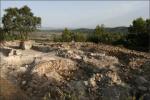Summary (English)
The settlement is located in the east of the village of Agres, on the northern slope of the Sierra de Mariola. The settlement sits on a protruding spur inclining toward the valley, forming an irregular ovular plateau.
The excavations were initiated in the late 1970s under the leadership of M. Gil-Mascarell; from 1966 works were resumed with an interdisciplinary focus in order to conduct an exhaustive study of the site and its integration into the surrounding environment.
The works carried out during the 2008 season focused on Sector I, where 11 post holes in a parallel line in the exterior of a loam wall were identified, creating various workspaces that follow the standard unroofed work area.
Amongst the material recovered in this zone the bone and ivory carved items stand out in particular (buttons with central perforation, pyramidal buttons…). Ivory fragments corresponding to the first stage of the production process (prism matrices, ivory raw slices, etc.) have also been recovered. This indicates that this is a well-defined space which is completely separated from the habitat area; this zone was used for carving ivory and bone. We have found evidence from each stage of the manufacturing sequence from the bulk raw material to the completed ornament. There are few sites presenting the complete operational chain as documented in Mola d’Agres; the most important are El Acequión (Albacete) or El Cerro de la Encantada (Ciudad Real).
In addition, during the 2008 season the immediate vicinity of Room I was excavated. Here, another house was identified to the west of the preceding structure, with similar morphology but rather smaller dimensions; in its interior, two post hole supporting the roof were discovered.(translation by Esther Casares Carmona)
- Teresa Huélamo, Elena Grau, José Luis Peña, José Morejón, Jorge Contreras, José Vicente Escusa, Marta Blasco, Marta Castillo, Esther Pérez y Mª José García
Director
- José Luis Peña Sánchez, Elena Grau Almero y Teresa Huélamo Doménech
Team
- MARQ, Museo Arqueológico Provincial de Alicante
Research Body
- Colegio Oficial de Doctores y Licenciados en Filosofía y Letras y en Ciencias de Alicante - Sección de Arqueología
- Universidad de Valencia
Funding Body
- Universidad de Valencia






![Download [PDF]](/excavation/skins/fasti/images/results/download_sml.png)
